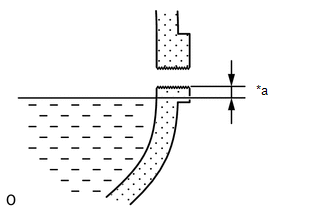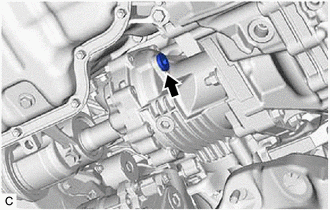Toyota Camry (XV70): On-vehicle Inspection
ON-VEHICLE INSPECTION
PROCEDURE
1. REMOVE FRONT WHEEL OPENING EXTENSION PAD RH
Click here
.gif)
.gif)
.gif)
2. REMOVE FRONT WHEEL OPENING EXTENSION PAD LH
Click here .gif)
.gif)
.gif)
3. REMOVE NO. 1 ENGINE UNDER COVER
Click here
.gif)
.gif)
.gif)
4. REMOVE NO. 2 ENGINE UNDER COVER ASSEMBLY
Click here .gif)
.gif)
.gif)
5. CHECK TRANSFER OIL
(a) Stop the vehicle on a level surface.
| (b) Using a 10 mm straight hexagon wrench and 10 x 12 mm long offset wrench, remove the transfer filler plug and gasket from the transfer assembly. |
|
| (c) Check that the oil level is between 0 to 5 mm (0 to 0.197 in.) from the bottom lip of the transfer filler plug hole.
If the result is not as specified, add transfer oil. Oil Type and Viscosity:
Toyota genuine differential gear oil LT SAE 75W-85 API GL-5 or equivalent
NOTICE:
- Using transfer oil other than the specified oil may cause abnormal noise or vibration, or damage the transfer of the vehicle.
- When adding transfer oil, pour it slowly.
- Too much or too little transfer oil will lead to transfer problems.
|
 |
|
*a | 0 to 5 mm (0 to 0.197 in.) | | |
(d) If the oil level is low, refill transfer oil after checking for oil leaks.
| (e) Using SST, a 10 mm straight hexagon wrench and 10 mm union nut wrench, install the transfer filler plug and a new gasket to the transfer assembly.
SST: 09961-00950 Torque: Specified tightening torque :
39 N |
READ NEXT:
REPLACEMENT PROCEDURE 1. REMOVE FRONT WHEEL OPENING EXTENSION PAD RH
Click here
2. REMOVE FRONT WHEEL OPENING EXTENSION PAD LH Click here
3. REMOVE NO. 1 ENGINE UNDER COVER
Click h
PrecautionPRECAUTION
PRECAUTION (a) Before disassembling the transfer assembly, thoroughly clean it to remove any foreign matter. This will help prevent contamination inside the transfer during disa
SEE MORE:
INSPECTION PROCEDURE 1. INSPECT CAMSHAFT TIMING GEAR BOLT
(a) Check the stroke of the plunger in the center of the camshaft timing gear bolt.
Standard Stroke: 2.2 mm (0.0866 in.) or more HINT: When pressing the plunger, there may be a stepped feeling. This is not a malfunction.
If the r
FAIL-SAFE CHART FAIL-SAFE CHART Dynamic Torque Control AWD System
DTC No. Trouble Area
AWD Warning Message Fail-safe Operation
Memory Fail-safe Deactivation Condition
C120C Linear Solenoid Power Supply System Malfunction
Displayed Prohibited
Yes Igniti
.gif)
.gif)
.gif)
.gif)
.gif)
.gif)
.gif)
.gif)
.gif)
.gif)
.gif)
.gif)



